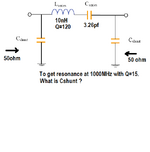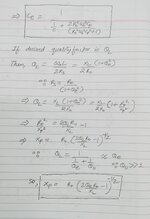afz23
Full Member level 3

Hi ,
I was reading about a simple resonator design and found a relation of shunt reactance to set loaded Q of series
resonator in a 50 ohm system to a desired value.
I tried a few times,but some how I am not getting this 'Xshunt' relation,when I solve it on my own.
Same relation is mentioned in the reference book by Vendelin,but there also direct formula is given not the derivation.
I need help to understand the procedure to get Xshunt formula as mentioned in the attached design here.
I hope this is well known to resonator designers,kindly throw some light on this formula.
thanks
I was reading about a simple resonator design and found a relation of shunt reactance to set loaded Q of series
resonator in a 50 ohm system to a desired value.
I tried a few times,but some how I am not getting this 'Xshunt' relation,when I solve it on my own.
Same relation is mentioned in the reference book by Vendelin,but there also direct formula is given not the derivation.
I need help to understand the procedure to get Xshunt formula as mentioned in the attached design here.
I hope this is well known to resonator designers,kindly throw some light on this formula.
thanks




